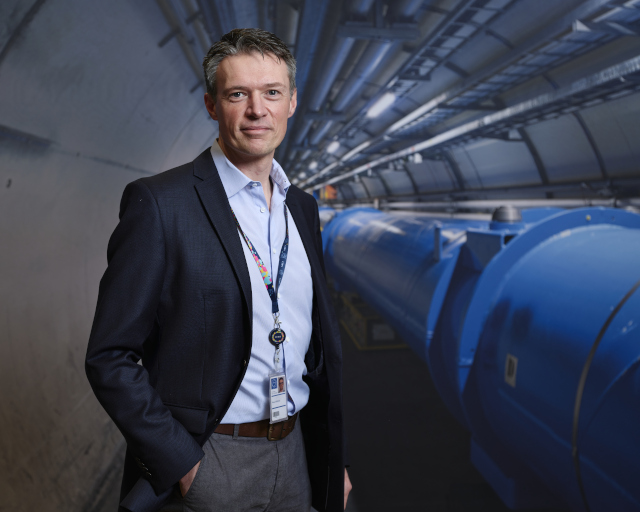
CERN Environment Report :
2023–2024
FOREWORD
Fabiola Gianotti, Director-General
CERN’s environmental commitments extend far beyond 2030. As we move towards the final stretch of LHC Run 3 and prepare for the next chapter of our scientific programme — first and foremost the High-Luminosity LHC — environmental stewardship remains at the heart of our strategy.
Click to read the full statement
The years 2023 and 2024 have been marked by extraordinary achievements in CERN’s scientific programme and more generally across the full spectrum of the Organization’s activities, with a particular focus on environmental responsibility.
As an example, in 2024 the Large Hadron Collider (LHC) delivered an integrated luminosity of 124 inverse femtobarns to the ATLAS and CMS experiments — a record-breaking performance that also highlighted the increasing efficiency of CERN’s accelerator complex in terms of data delivered per unit of energy consumed. CERN also inaugurated a new data centre with a power usage effectiveness of 1.1, which is significantly better than the European average, and equipped with an efficient heat-recovery system.
This reporting period was also a time of reflection and celebration, as CERN marked 70 years of discoveries, breakthroughs and innovation. Events held throughout 2024 brought together our global community, international partners and world leaders to honour CERN’s achievements and reaffirm our shared values of excellence, collaboration, diversity and inclusion, openness and care for people and the environment. As we move towards the final stretch of LHC Run 3 and prepare for the next chapter of our scientific programme—first and foremost the High-Luminosity LHC—environmental stewardship remains at the heart of our strategy.
Looking further ahead, in early 2024 the CERN Council conducted a mid-term review of the study assessing the feasibility of a possible Future Circular Collider, which is being undertaken following the recommendations of the 2020 update of the European Strategy for Particle Physics (ESPP). The study report details the concepts, strategies and actions required to respect the environment, in line with CERN’s environmental objectives, while boosting new technologies with the potential to help society to protect the planet and developing territorial synergies such as energy reuse. Shortly afterwards, the Council set in motion the process to update the ESPP in 2026; as in the past, the updated Strategy is expected to place emphasis on actions to improve the sustainability of our field.
In February 2023, CERN was granted ISO 50001 certification, the benchmark international standard for energy management, in recognition of the Organization’s achievements in this domain and of its commitment to continuous improvement. The following January, the Enlarged Directorate approved CERN’s revised environmental objectives for 2030, which introduce further constraints in domains including electricity consumption, direct CO2 emissions, water usage and waste.
CERN’s environmental commitments extend far beyond 2030. Building on the tremendous innovation and ingenuity that underpin the successful construction and operation of some of the world’s largest and most advanced scientific instruments, a future flagship project will be a model for environmentally aware, sustainable research. CERN will thus continue to demonstrate that we can and must push back the frontiers of knowledge and technology while protecting the world we all share.
Fabiola Gianotti, Director-General


Benoît Delille, Head of the Occupational Health and Safety and Environmental Protection unit
Science should not just address global challenges but act locally. And that is what we do at CERN. The operation of complex infrastructures such as CERN’s accelerators and experiments presents unique challenges, and it is through the engagement of our entire community that we are able to meet them.
Click to read the full statement
Science should not just address global challenges but act locally. And that is what we do at CERN. The operation of complex infrastructures like CERN’s accelerators and experiments presents unique challenges, and it is through the engagement of our entire community that we are able to meet them.
Over the past two years, CERN has continued to demonstrate how large-scale scientific research can be conducted with a conscious commitment to environmental responsibility and continuous improvement. The period 2023–2024 was characterised not only by the exceptional performance of the accelerators, experiments and computing, but also by important steps forward in our environmental and sustainability actions. Apart from a month-long stop in 2023 due to a technical issue, the accelerator complex was in full operation throughout this period at the LHC energy level of 13.6 TeV.
As the LHC broke new records in integrated luminosity, we maintained our focus on optimising resource use, enhancing energy efficiency and reducing our environmental footprint. In 2023-2024, CERN made significant progress toward its environmental objectives for the period up to the end of Run 3 in the priority domains of energy, emissions, water and waste. This reporting period was also significant in preparing for CERN’s next strategic phases – the end of LHC Run 3, the technical stop and Long Shutdown 3, which pave the way to the High-Luminosity LHC – and the long-term vision towards a possible Future Circular Collider.
New and revised environmental objectives for 2030 were approved by the Enlarged Directorate in January 2024. While the collision rate during Run 4 (2030-2033) will be multiplied by approximately a factor of five with respect to the nominal LHC design, CERN has committed to limiting its electricity consumption to 1.5 TWh/year and to reducing the direct CO2 emissions linked to its core operations by 50%. CERN has also pledged to reduce its gas consumption by 60% with respect to the 2018 figures and to keep its water consumption below 3600 megalitres, despite a growing demand for cooling water. The newly endorsed 2030 environmental objectives also set clear priorities in domains including biodiversity, ionising radiation and noise.
The vision set out by the Director-General ten years ago for CERN to be a role model for environmentally responsible research has pushed our scientists, engineers and technicians to define ambitious yet realistic objectives. I am grateful to everyone at CERN who contributes daily to building a safer, more sustainable laboratory that balances scientific excellence with care for the environment.
Benoît Delille, Head of the Occupational Health and Safety and Environmental Protection unit
IN BRIEF:
The accelerator complex was in full operation throughout this period, following its restart in July 2022 with a view to reaching the new energy level of 13.6 TeV. Operating periods feature short shutdowns of several weeks at the end of each year for the purposes of essential maintenance. In 2024, a revised schedule for the operation and shutdown of the accelerator complex was approved, delaying the end of Run 3 and the start of the third long shutdown to mid-2026.

1290 GWh
CERN has committed to limiting rises in electricity consumption by the end of Run 3 to 5% compared to the baseline year 2018, while delivering significantly increased performance of its facilities. This corresponds to a maximum target consumption of 1 317 GWh. It has also committed to increasing energy reuse.
CERN consumed 1 096 GWh of electricity in 2023 and 1 290 GWh in 2024. It also consumed 43 GWh (154 TJ) of energy generated by fossil fuels in both reporting years.

170 024 tCO2e
CERN’s objective is to reduce its direct emissions by 28% by the end of Run 3 compared to the baseline year 2018 (maximum target 138 300 tCO2e).
In 2023 and 2024, respectively:
– Direct Scope 1 emissions amounted to 170 482 and 170 024 tonnes of CO2 equivalent (tCO2e);
– Indirect Scope 2 greenhouse gas emissions due to CERN’s electricity consumption were 63 572 and 66 965 tCO2e;
– Indirect Scope 3 emissions arising from business travel, personnel commuting, catering, waste treatment and water purification (excluding procurement) amounted to 10 091 and 11 553 tCO2e. Those arising from procurement amounted to 100 512 and 102 730 tCO2e.

2 895 ML
The Laboratory has committed to keeping the increase in its water consumption up to the end of Run 3 below 5% compared to the baseline year 2018, which corresponds to a target maximum consumption of 3 651 megalitres despite the growing demand for water cooling at the upgraded facilities.
CERN used 2 830 megalitres of water in 2023 and 2 895 megalitres of water in 2024.

76% recycled
CERN’s aim is to continuously increase its recycling rate for non-hazardous waste. This rate rose from 56% in 2018 to 76% in 2024.
In 2023 and 2024 respectively, CERN disposed of 3 625 tonnes and
3 419 tonnes of non-hazardous waste, and of 1 379 tonnes and 975 tonnes of hazardous waste (both conventional and radioactive).

50 hectares of areas of ecological interest
CERN’s biodiversity action plan for 2021-2025 comprises a set of initiatives designed to preserve and enhance its natural environment. These objectives are founded on Host State regulations and best practices in the field of biodiversity. The inventory of fauna and flora completed in 2022 identified some 50 hectares of areas of ecological interest, to be classed as a priority for preservation in the event of planned works and projects.

25 projects
The CERN Innovation Programme on Environmental Applications (CIPEA) was launched in 2022 as a call for ideas from the CERN community to stimulate innovation in environmental applications based on CERN’s technologies, know-how and facilities.
The programme was expanded during the reporting period to include projects defined in collaboration with external partners, mainly from industry, in the key areas identified in the 2022 strategy. The eight CERN community projects initially selected are generating the first results.

<0.01 mSv
The European annual dose limit for public exposure to artificial sources is 1 millisievert (mSv). CERN has committed to keeping its contribution to no more than 0.3 mSv per year. In 2024, the dose received by any member of the public living near the Laboratory was below 0.01 mSv.

45 dBA at night
CERN has committed to restricting the level of noise at its site perimeters to 70 dBA during the day and 60 dBA at night.
The average noise levels measured at CERN’s site perimeters are typically 50 dBA during the day and 45 dBA at night. In addition, CERN continues to monitor the evolution of noise levels in residential areas next to its sites, keeping noise footprint maps and 3D noise models up to date.

The Organization took an important step towards integrating sustainability into its procurement processes by adopting an Environmentally Responsible Procurement Policy along with an implementation strategy, both of which were approved by CERN’s Enlarged Directorate in 2023.
CERN’s materials needs are driven by the demands of cutting-edge scientific research, technology and infrastructure, which require materials of exceptional quality with unique characteristics. This report features CERN’s materials management practices for the first time.

>100 m3 mineral oil removed
CERN’s regulatory framework for hazardous substances addresses potential risks to soil and water and is continuously adapted in line with Host State regulations. These substances are subject to regular monitoring and reporting.

CONTENTS
Introduction
Domains
Reference
Explore the report online or download it as a PDF.
Questions regarding this report may be addressed to environment.report@cern.ch.